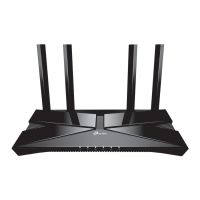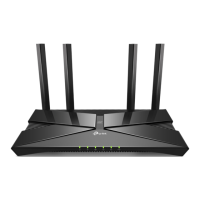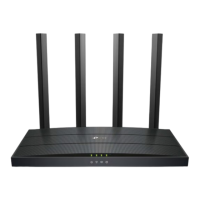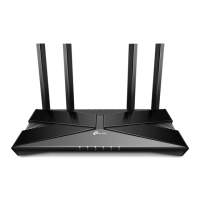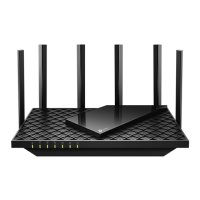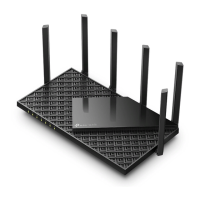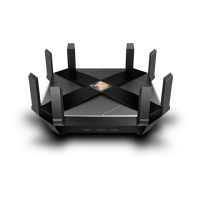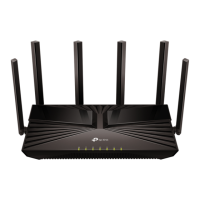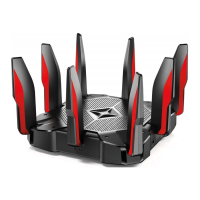Do you have a question about the TP-Link Archer AX3000 and is the answer not in the manual?
Overview of the router's features, technology, and setup convenience.
Explanation of the router's top panel, including LED indicators.
Description of the router's back panel, including ports and buttons.
Detailed explanation of router buttons and port functions.
Guidelines for optimally placing the router for best performance and safety.
Step-by-step instructions for physically connecting the router to the modem and power.
Instructions for connecting computers via wired, wireless, or WPS methods.
Guide on how to access the router's web management page for configuration.
Step-by-step guide for quick internet setup using the router's wizard.
Instructions for setting up internet connection using the TP-Link Tether mobile application.
Guide to manually configure various internet connection types like PPPoE, Static IP.
How to configure the router to function as an Access Point for an existing network.
Configuration steps for setting up an IPv6 internet connection.
Guide on creating a TP-Link account for cloud management.
Instructions for updating email address and password for your TP-Link ID.
Information on adding/removing user accounts and their permissions.
Using the TP-Link Tether app for remote router management.
Steps to set up a separate Wi-Fi network for guests.
Options to control guest access, security, and privacy.
How to access files on a connected USB drive from within the local network.
Guide to accessing USB storage from outside the local network.
Options for setting up sharing accounts, folders, and access addresses.
Enabling and using the Media Sharing feature for DLNA devices.
Configuring the router for Time Machine backups from Mac computers.
Configuring restrictions on internet access for family members.
Tracking and viewing a child's online activities and website visits.
Prioritizing network traffic for specific devices or applications.
How to enable and configure the router's SPI firewall.
Blocking or allowing specific devices using Blacklist or Whitelist.
Preventing ARP spoofing by binding IP addresses to MAC addresses.
Sharing local resources like websites or FTP servers to the internet.
Dynamically opening ports for specific applications like online games.
Exposing a PC to the internet to bypass port restrictions.
Enabling UPnP to improve performance for online gaming and P2P applications.
Guide to configuring the router as an OpenVPN server for remote access.
Steps for setting up the OpenVPN client on a remote device.
Configuring the router as a PPTP VPN server for remote access.
Steps for setting up the PPTP VPN client on a remote Windows device.
Modifying the router's local IP address and subnet mask.
Combining network ports for increased bandwidth and stability.
Setting up the router to support Internet/IPTV/Phone services from your ISP.
Configuring IP address assignment and reservations for network devices.
Using DDNS to access your router remotely via a domain name.
Manually configuring routing paths for network traffic.
Customizing SSID, password, security, and advanced wireless features.
Setting up secure Wi-Fi connections using WPS Push Button or PIN.
Automating the turning on/off of wireless networks at scheduled times.
Configuring the router's internal clock for accurate timekeeping and time-based features.
Options to turn router LEDs on/off or enable Night Mode.
Using diagnostic tools like Ping and Traceroute to check network status.
Instructions for updating the router's firmware via online or manual methods.
Saving and restoring router configuration files, including factory resets.
Scheduling automatic reboots to maintain router performance.
Modifying the router's login password for web management.
Configuring the feature to recover forgotten router login passwords.
Controlling device access to the router's management interface via MAC address.
Enabling and configuring remote access to manage the router from outside the network.
Saving and sending router system logs for troubleshooting.
Viewing network traffic usage for devices and the overall network.
Configuring advanced wireless and NAT parameters for network optimization.
Configuring the router to work with Amazon Alexa for voice control.
Steps to recover or reset your Wi-Fi password.
Procedures for recovering or resetting the router's web management password.
Troubleshooting steps for issues accessing the router's management interface.
Overview of the router's features, technology, and setup convenience.
Explanation of the router's top panel, including LED indicators.
Description of the router's back panel, including ports and buttons.
Detailed explanation of router buttons and port functions.
Guidelines for optimally placing the router for best performance and safety.
Step-by-step instructions for physically connecting the router to the modem and power.
Instructions for connecting computers via wired, wireless, or WPS methods.
Guide on how to access the router's web management page for configuration.
Step-by-step guide for quick internet setup using the router's wizard.
Instructions for setting up internet connection using the TP-Link Tether mobile application.
Guide to manually configure various internet connection types like PPPoE, Static IP.
How to configure the router to function as an Access Point for an existing network.
Configuration steps for setting up an IPv6 internet connection.
Guide on creating a TP-Link account for cloud management.
Instructions for updating email address and password for your TP-Link ID.
Information on adding/removing user accounts and their permissions.
Using the TP-Link Tether app for remote router management.
Steps to set up a separate Wi-Fi network for guests.
Options to control guest access, security, and privacy.
How to access files on a connected USB drive from within the local network.
Guide to accessing USB storage from outside the local network.
Options for setting up sharing accounts, folders, and access addresses.
Enabling and using the Media Sharing feature for DLNA devices.
Configuring the router for Time Machine backups from Mac computers.
Configuring restrictions on internet access for family members.
Tracking and viewing a child's online activities and website visits.
Prioritizing network traffic for specific devices or applications.
How to enable and configure the router's SPI firewall.
Blocking or allowing specific devices using Blacklist or Whitelist.
Preventing ARP spoofing by binding IP addresses to MAC addresses.
Sharing local resources like websites or FTP servers to the internet.
Dynamically opening ports for specific applications like online games.
Exposing a PC to the internet to bypass port restrictions.
Enabling UPnP to improve performance for online gaming and P2P applications.
Guide to configuring the router as an OpenVPN server for remote access.
Steps for setting up the OpenVPN client on a remote device.
Configuring the router as a PPTP VPN server for remote access.
Steps for setting up the PPTP VPN client on a remote Windows device.
Modifying the router's local IP address and subnet mask.
Combining network ports for increased bandwidth and stability.
Setting up the router to support Internet/IPTV/Phone services from your ISP.
Configuring IP address assignment and reservations for network devices.
Using DDNS to access your router remotely via a domain name.
Manually configuring routing paths for network traffic.
Customizing SSID, password, security, and advanced wireless features.
Setting up secure Wi-Fi connections using WPS Push Button or PIN.
Automating the turning on/off of wireless networks at scheduled times.
Configuring the router's internal clock for accurate timekeeping and time-based features.
Options to turn router LEDs on/off or enable Night Mode.
Using diagnostic tools like Ping and Traceroute to check network status.
Instructions for updating the router's firmware via online or manual methods.
Saving and restoring router configuration files, including factory resets.
Scheduling automatic reboots to maintain router performance.
Modifying the router's login password for web management.
Configuring the feature to recover forgotten router login passwords.
Controlling device access to the router's management interface via MAC address.
Enabling and configuring remote access to manage the router from outside the network.
Saving and sending router system logs for troubleshooting.
Viewing network traffic usage for devices and the overall network.
Configuring advanced wireless and NAT parameters for network optimization.
Configuring the router to work with Amazon Alexa for voice control.
Steps to recover or reset your Wi-Fi password.
Procedures for recovering or resetting the router's web management password.
Troubleshooting steps for issues accessing the router's management interface.
| Wi-Fi Standard | Wi-Fi 6 (802.11ax) |
|---|---|
| Bands | Dual-band |
| Maximum Wi-Fi Speed | 3000 Mbps |
| Ethernet Ports | 1x Gigabit WAN, 4x Gigabit LAN |
| Processor | 1.5 GHz Triple-Core CPU |
| Antenna | 4 external antennas |
| MU-MIMO | Yes |
| Beamforming | Yes |
| OFDMA | Yes |
| USB Ports | 1x USB 3.0 |
| Security | WPA3, WPA2, WPA |
| Features | QoS, VPN Server |
| Dimensions | 10.2 x 5.3 x 1.5 inches |
